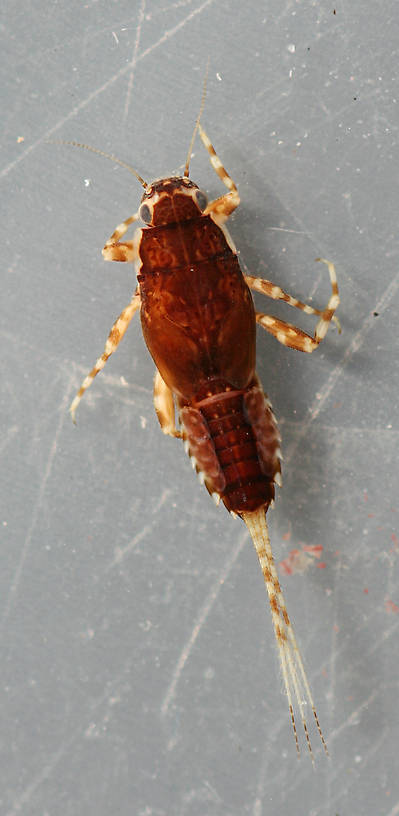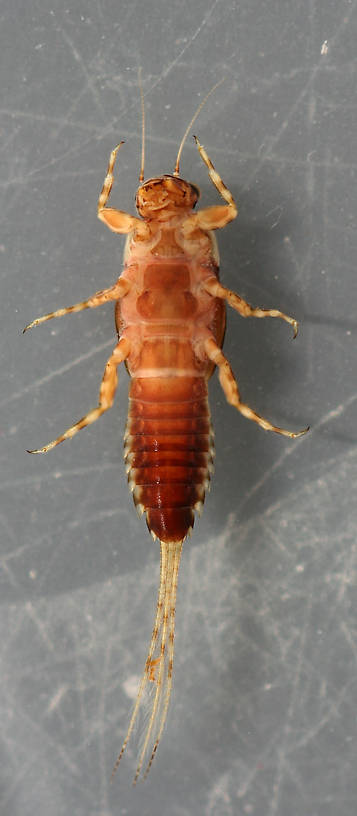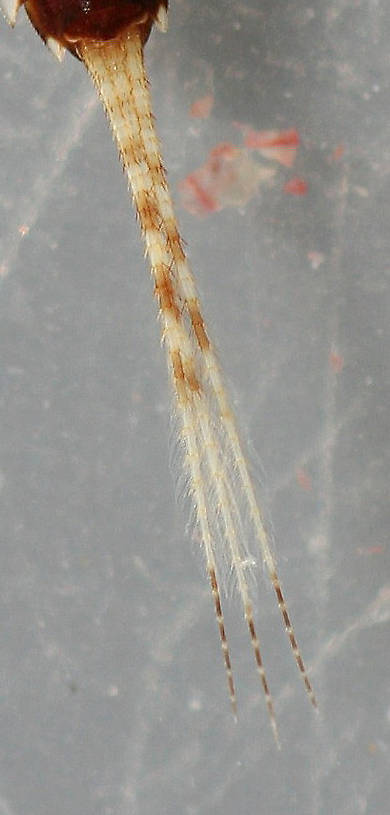Blog & Latest Updates
Fly Fishing Articles
Insects by Common Name


> > Ephemerella dorothea infrequens ?






| Millcreek | December 22nd, 2015, 4:50 pm | |
| Healdsburg, CA Posts: 356 | I usually find these on submerged branches and roots from January-March. The nymphs are found primarily in Mill Creek and occasionally in the Russian River. The nymphs are approximately 6-8 mm in length excluding the cerci. They exhibit a fairly wide range of color patterns. I put them in the identification section because I'm still unsure of my identification. I keyed them to genus with Merritt, Cummins and Berg (2008) and to species with Allen and Edmunds "A Subdivision Of the Genus Ephemerella (Ephemeroptera: Ephemerellidae). VIII. The Subgenus Ephemerella in North America." and Johnson's "Larvae of Ephemerella inermis and E. infrequens." Ephemerella inermis is a synonym for E. excrucians and Ephemerella infrequens is a synonym for E. dorothea infrequens. Any help would be appreciated. Mark | |
| Wbranch | December 22nd, 2015, 4:52 pm | |
| York & Starlight PA Posts: 2733 | Were you planning to include pictures? | |
| Catskill fly fisher for fifty-five years. | ||
| Millcreek | December 22nd, 2015, 5:11 pm | |
| Healdsburg, CA Posts: 356 | Were you planning to include pictures? They're there. Just a little slow. Mark | |
| Lastchance | December 22nd, 2015, 6:02 pm | |
| Portage, PA Posts: 437 | In reference to the last photo, are those light and dark sulfurs? | |
| Millcreek | December 22nd, 2015, 6:35 pm | |
| Healdsburg, CA Posts: 356 | Yeah, they are. About 10 to 15% are the dark ones. | |
| Feathers5 | December 23rd, 2015, 8:17 am | |
| Posts: 287 | Yeah, they are. About 10 to 15% are the dark ones. Why are some dark and some light. Are they different sub-species? | |
| Millcreek | December 23rd, 2015, 10:45 am | |
| Healdsburg, CA Posts: 356 | Why are some dark and some light. Are they different sub-species? I don't know why some are dark and some light. Just a shake-up in the genes, I suspect. In all other respects they are identical. And they are not a separate subspecies, at least not so far. | |
| Oldredbarn | December 24th, 2015, 3:36 pm | |
| Novi, MI Posts: 2608 | Maybe male/female? The darker one may be the female. It appears slightly larger than the reddish one...They are related to our invaria and subvaria...The male "Hennies" here, E subvaria, are sized differently and have different color schemes than the female of the same species... Nice pics! Spence | |
| "Even when my best efforts fail it's a satisfying challenge, and that, after all, is the essence of fly fishing." -Chauncy Lively "Envy not the man who lives beside the river, but the man the river flows through." Joseph T Heywood | ||
| Millcreek | December 27th, 2015, 10:08 am | |
| Healdsburg, CA Posts: 356 | Spence, I don't think it's male/female because there are only a relatively small number of the dark ones (10-15%). Nice pics! Thanks! Mark | |
| Wbranch | December 27th, 2015, 1:15 pm | |
| York & Starlight PA Posts: 2733 | In my opinion the Ep dorothea has the same importance as the Ep subvaria east of the Mississippi. One difference being the emergence period for dorotheas is much longer than that of subvaria. When I used to spend the months of June through August in Montana I was able to fish the dorothea for most of those three months on the fertile spring creeks. | |
| Catskill fly fisher for fifty-five years. | ||
| Entoman | December 30th, 2015, 11:41 pm | |
| Northern CA & ID Posts: 2604 | Happy New Year to all troutnuts! This group of (sub?) species is perhaps the most difficult to identify with any certainty... Matt - Most of the hatches you've fished out West were NOT E. D. infrequens (though they were PMD's), Mark - Why do you believe the specimens in your photos are this subspecies? | |
| "It's not that I find fishing so important, it's just that I find all other endeavors of Man equally unimportant... And not nearly as much fun!" Robert Traver, Anatomy of a Fisherman | ||
| Millcreek | December 31st, 2015, 10:37 am | |
| Healdsburg, CA Posts: 356 | Kurt - I believe these are E. d. infrequens because they came out to E. dorothea or E. inermis (now E. d. infrequens and E. excrucians) in Allen and Edmunds 'A Revision of the Genus Ephemerella (Ephehemerota: Ephemerellidae). VIII. The Subgenus Ephemerella in North America.' http://www.ephemeroptera-galactica.com/pubs/pub_a/puballenr1965p244.pdf Then I went to Johnson's 'Larvae of Ephemerella inermis and E. infrequens' which had to do with the setae on the legs and the curvature of the claw. http://www.ephemeroptera-galactica.com/pubs/pub_j/pubjohnsons1978p19.pdf The setae and claw curvature most closely resembles E. dorothea infrequens (referred to as E. infrequens in Johnson's account). That's a rather longwinded account of how I got the identification but I believe it's correct.:) | |
| Jmd123 | December 31st, 2015, 3:05 pm | |
| Oscoda, MI Posts: 2611 | Mark, just have to comment on how beautiful your photography is! You should consider publishing a color field guide to these creatures. Heck, these photos would make good wall-hangers for the fly-fishing minded - I did a bunch of wildflower & wildlife photos for Christmas gifts this year and I could easily see one of your photos in a nice frame up on the wall here in my computer/fly-tying room. Happy New Year! Jonathon | |
| No matter how big the one you just caught is, there's always a bigger one out there somewhere... | ||
| Wbranch | December 31st, 2015, 7:52 pm | |
| York & Starlight PA Posts: 2733 | Hello Kurt, Happy New Year to you too and all the other Forum members. Most of the hatches you've fished out West were NOT E. D. infrequens (though they were PMD's), If they were not E. D. infrequens what were they? Also do you think the PMD's I see on the Missouri are EDi or some other bug? I'm curious only from an interest to further my knowledge. As far as how I tie the flies, or what they are called, I could care less. I know certain patterns work very well and others, like the duns, work very poorly for the Missouri River trout. | |
| Catskill fly fisher for fifty-five years. | ||
| Millcreek | January 1st, 2016, 5:58 pm | |
| Healdsburg, CA Posts: 356 | Jonathan, Thanks for the encouraging words. It's hard finding people who want pictures of bugs on their walls.:) Mark | |
| Jmd123 | January 1st, 2016, 6:26 pm | |
| Oscoda, MI Posts: 2611 | Mark, people have butterflies mounted in cases up on their walls, why not photos of mayfly nymphs? Many years ago my ex-wife got me an aquatic entomology calendar which featured a "hatch of the month" illustration consisting of a magnified view drawing in color detail of an aquatic insect. I think the bug for June was a Pteronarcys salmonfly adult if I remember correctly...so yeah, I'm the kind of person who would hang bug pictures on their walls. Sent my daughter three frogs and a snake for Christmas - pictures that is, not the critters themselves! She already has a four-foot ball python for a pet... Jonathon | |
| No matter how big the one you just caught is, there's always a bigger one out there somewhere... | ||
| Entoman | January 7th, 2016, 12:29 am | |
| Northern CA & ID Posts: 2604 | Matt, Happy New Year to you as well! The hatches you are fishing out West are most likely E. excrucians. E. D. infrequens is larger than the former (in waters where they coexist) that hatches earlier, and only lasts a week or two. Even at high elevations it is usually done by the end of June. The smaller (again in waters where they coexist) and longer hatching (often all Summer) excrucians is the species most often encountered. Regardless, they're all "PMD's" as far as anglers are concerned. Personally, I have found over the years that the larger species is a better "dry fly" bug. By the time the little guys come around, the fish are quite picky. Cripples, nymphs, and emergers become the order of the day - and it's becoming increasingly more difficult to fool fish on hard fished waters after the first month. It's a rare day to find a pattern that works for more than a couple of fish from the same pod. Anglers are better off switching patterns or moving to a new location. Hard to do with rising fish all around you!:) Mark, The only way I've found to identify these critters with (somewhat) certainty is through an intimate knowledge of a particular watershed. Taxonomy used in isolation isn't much help as the two species are virtually identical. To my knowledge, there has yet to be discovered any taxonomical difference in the nymphal stage proved reliable. If both species inhabit the watershed (which is most of the time) it can be done easily based on the comments above to Matt. When both aren't, it can be trickier. Infrequens can be as small as 16 in some watersheds and as large as 12 in others - excrucians can be as large as 14 and as small as 18, depending on the waters they inhabit. The only constants seem to be that infrequens hatches much earlier, is short lived, and it is larger if both are in the same watershed. While an interesting paper, I haven't found differences in the claws to be very helpful anecdotally. This character difference (along with earlier presumptions of differences in dorsal maculation) isn't widely accepted as reliable... This group remains very confusing, with much left to learn. There's so much of our western water that has not been studied. I've sent many specimens of this group over the years to top entomologists that could not be identified to species... | |
| "It's not that I find fishing so important, it's just that I find all other endeavors of Man equally unimportant... And not nearly as much fun!" Robert Traver, Anatomy of a Fisherman | ||
| PaulRoberts | January 7th, 2016, 11:05 am | |
| Colorado Posts: 1776 | By the time the little guys come around, the fish are quite picky. Kurt, E. dorothea was often a difficult emergence to fish as well, even in smaller eastern streams that received little pressure. Drys often failed miserably leaving us to experiment with various subsurface creations. I wonder if there's something in their emergence that they share with excrucians? | |
| Wbranch | January 7th, 2016, 11:22 am | |
| York & Starlight PA Posts: 2733 | Kurt,By the time the little guys come around, the fish are quite picky. Cripples, nymphs, and emergers become the order of the day - and it's becoming increasingly more difficult to fool fish on hard fished waters after the first month. Before I knew better and learned that the trout in the MT river that I fish every year don't eat the duns after their first week of emerging I tied a couple dozen dun patterns every year after my trip. I kept thinking my duns were ineffective due to size, color, materials, you name it! I wound up tying well over 100 different style PMD's and none have ever really been successful. I have been told by the owners of the lodge where I stay that the trout do eat the duns for about one week after the emergence begins and after that they totally ignore the dun on the surface. I can fully attest to the accuracy of that statement because there have been a number of years where I really tried to fish the dun and know I was covering fish well with drag free floats and covering them over and over without ever getting a fish to eat the dun. I have not caught a fish on the dun since July of 2013 when I remember catching two trout over a ten day period. I have no problem catching them on emergers floating in the film or biot bodied spinners. They love to eat a #18 nymph trailed behind my dry fly but just refuse to stick their noses out to suck in a dun. It is weird since when I used to fish the Big Horn in eastern MT the trout loved to eat the duns. Also the trout on the Beaverhead and Armstrong Spring Creek are aggressive risers and are a pushover for a well cast PMD. | |
| Catskill fly fisher for fifty-five years. | ||
| Millcreek | January 7th, 2016, 12:39 pm | |
| Healdsburg, CA Posts: 356 | Kurt- The setae on the forelegs of E. d. infrequens seems to more closely match as well as the fact that the forelegs are longer. Also seems like the species I have collected from the creek and river are on the smaller side (6-8 mm, excluding cerci) and are in the creek early (Jan-Mar). Given those observations I would tend to go with E. d. infrequens rather than E. excrucians. Of course, I could be wrong. It's happened before.:) | |
Quick Reply
You have to be logged in to post on the forum. It's this easy:
Related Discussions
| Title | Replies | Last Reply |
| Re: pmd hatches in ny? In the Mayfly Genus Ephemerella by Trouthunter | 3 | Apr 19, 2009 by GONZO |
| Re: So is Ep Infrequens now known as Ep Dorothea? In the Mayfly Species Ephemerella dorothea infrequens by Wbranch | 20 | Jul 1, 2014 by Crepuscular |
| Re: Ephemerella dorothea nymphs In General Discussion by Wbranch | 10 | Jul 5, 2008 by Wbranch |
| Re: Pale Gray/White Spinner In General Discussion by WBMike | 6 | Sep 11, 2015 by Crepuscular |
| Ephemerella dorothea dorothea (PED) In the Identify This! Board by Wiflyfisher | 0 | |
| Re: Latin Help In General Discussion by Shawnny3 | 4 | Jul 20, 2006 by Shawnny3 |
| Re: Not invaria In Male Eurylophella Mayfly Spinner by GONZO | 2 | May 24, 2009 by GONZO |
| Re: Public service announcement: PMDs aren't yellow In Male Ephemerella excrucians Mayfly Dun by Troutnut | 13 | Aug 29, 2020 by Wiflyfisher |
| Re: Stonefly, very dark but what else can I find out? In Isoperla Stonefly Adult by IanB | 1 | May 5, 2009 by GONZO |
| Re: October Ephemerellid In the Identify This! Board by Crepuscular | 15 | Oct 22, 2013 by Entoman |
Troutnut.com is copyright © 2004-2024 Jason
Neuswanger (email Jason). See my FAQ for information about use of my images.
 privacy policy
privacy policy






